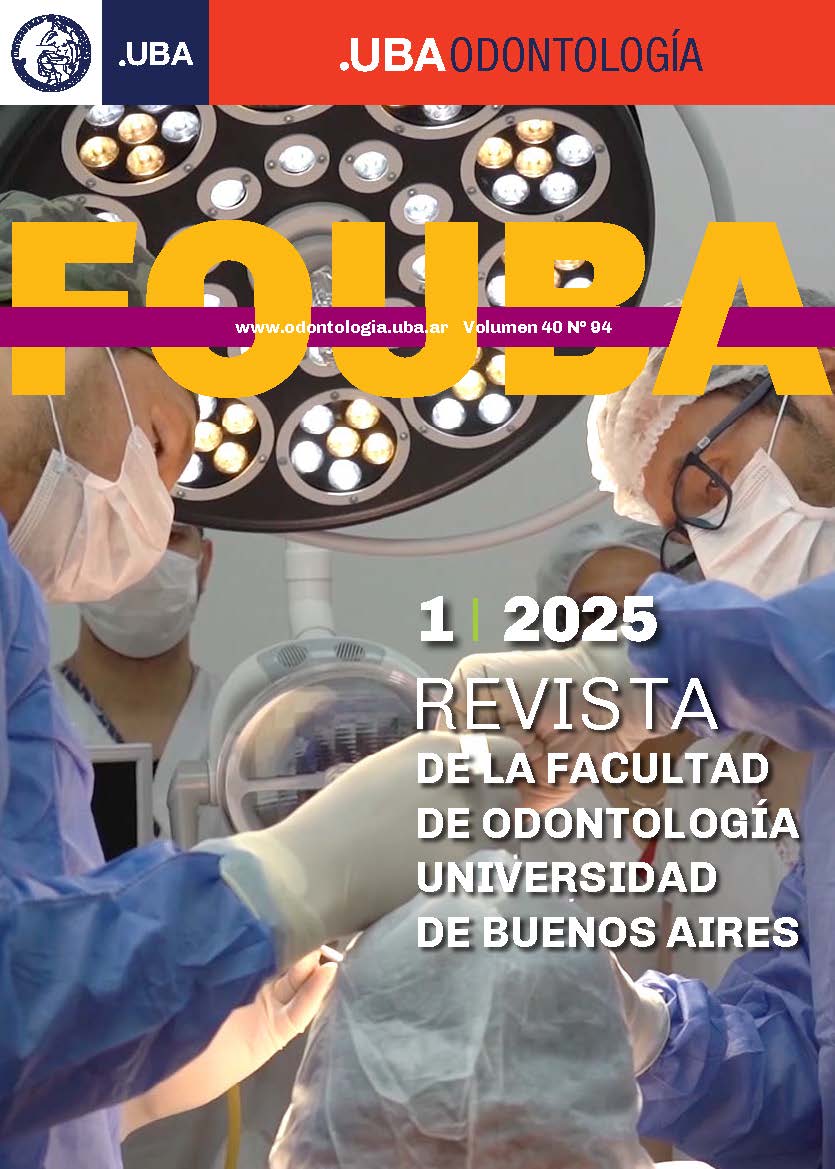Estado Actual del Conocimiento de la Etiología de la Dislocación Mandibular Anterior
DOI:
https://doi.org/10.62172/revfouba.n94.a251Palabras clave:
Articulación temporomandibular, dislocaciones, luxaciones, trastornos de la ATM, bloqueo abierto, cóndilo mandibularResumen
La dislocación de la articulación temporomandibular se define como el desplazamiento de la cabeza condilar por fuera de la cavidad glenoidea, más allá de la eminencia articular, que no se reduce espontáneamente a su posición normal. El siguiente trabajo tiene como objetivo realizar una revisión bibliográfica a fin de evaluar el rol que la morfología de las estructuras óseas que componen la articulación temporomandibular tiene en la génesis de la luxación mandibular.
Citas
Agbara, R., Fomete, B., Obiadazie, A. C., Idehen, K., y Okeke, U. (2014). Temporomandibular joint dislocation: experiences from Zaria, Nigeria. Journal of the Korean Association of Oral and Maxillofacial Surgeons, 40(3), 111–116. https://doi.org/10.5125/jkaoms.2014.40.3.111
Ahmad, M., Hollender, L., Anderson, Q., Kartha, K., Ohrbach, R., Truelove, E. L., John, M. T., y Schiffman, E. L. (2009). Research diagnostic criteria for temporomandibular disorders (RDC/TMD): development of image analysis criteria and examiner reliability for image analysis. Oral Surgery, Oral Medicine, Oral Pathology, Oral Radiology, and Endodontics, 107(6), 844–860. https://doi.org/10.1016/j.tripleo.2009.02.023
Akinbami B. O. (2011). Evaluation of the mechanism and principles of management of temporomandibular joint dislocation. Systematic review of literature and a proposed new classification of temporomandibular joint dislocation. Head & Face Medicine, 7, 10. https://doi.org/10.1186/1746-160X-7-10
Anantharam, B., Chahal, N., Stephens, N., y Senior, R. (2010). Temporo-mandibular joint dislocation: an unusual complication of transoesophageal echocardiography. European Journal of Echocardiography, 11(2), 190–191. https://doi.org/10.1093/ejechocard/jep178
Avidan A. (2002). Dislocation of the temporomandibular joint due to forceful yawning during induction with propofol. Journal of Clinical Anesthesia, 14(2), 159–160. https://doi.org/10.1016/s0952-8180(01)00374-9
Bordoni, B. y Varacallo, M. (2023). Anatomy, head and neck, temporomandibular joint [en línea]. Treasure Island (FL): StatPearls Publishing. https://www.ncbi.nlm.nih.gov/books/NBK538486/
Buckingham, R. B., Braun, T., Harinstein, D. A., Oral, K., Bauman, D., Bartynski, W., Killian, P. J., y Bidula, L. P. (1991). Temporomandibular joint dysfunction syndrome: a close association with systemic joint laxity (the hypermobile joint syndrome). Oral Surgery, Oral Medicine, and Oral Pathology, 72(5), 514–519. https://doi.org/10.1016/0030-4220(91)90485-u
Chan, T. C., Harrigan, R. A., Ufberg, J., y Vilke, G. M. (2008). Mandibular reduction. The Journal of Emergency Medicine, 34(4), 435–440. https://doi.org/10.1016/j.jemermed.2007.06.037
Chen, Y. C., Chen, C. T., Lin, C. H., y Chen, Y. R. (2007). A safe and effective way for reduction of temporomandibular joint dislocation. Annals of Plastic Surgery, 58(1), 105–108. https://doi.org/10.1097/01.sap.0000232981.40497.32
Chopko, T. C., y Lindsley, C. W. (2018). Classics in chemical neuroscience: risperidone. ACS Chemical Neuroscience, 9(7), 1520–1529. https://doi.org/10.1021/acschemneuro.8b00159
Cohen, A., Sela, M. C., Shooraki, N., Alterman, M., y Casap, N. (2021). The influence of articular eminence morphology on temporomandibular joint anterior dislocations. Oral Surgery, Oral Medicine, Oral Pathology and Oral Radiology, 131(1), 9–15. https://doi.org/10.1016/j.oooo.2020.07.017
Cohen, A., Sela, M. C., Verkauf, T. A., Alterman, M., Talisman, S., y Casap, N. (2021). The influence of mandibular condyle morphology on TMJ anterior dislocations. Oral Surgery, Oral Medicine, Oral Pathology and Oral Radiology, 132(4), 393–397. https://doi.org/10.1016/j.oooo.2021.03.008
Conti, P. C., Miranda, J. E., y Araujo, C. R. (2000). Relationship between systemic joint laxity, TMJ hypertranslation, and intra-articular disorders. Cranio : The Journal of Craniomandibular Practice, 18(3), 192–197. https://doi.org/10.1080/08869634.2000.11746132
Domino, K. B., Posner, K. L., Caplan, R. A., y Cheney, F. W. (1999). Airway injury during anesthesia: a closed claims analysis. Anesthesiology, 91(6), 1703–1711. https://doi.org/10.1097/00000542-199912000-00023
Dworkin, S. F., y LeResche, L. (1992). Research diagnostic criteria for temporomandibular disorders: review, criteria, examinations and specifications, critique. Journal of Craniomandibular Disorders : Facial & Oral Pain, 6(4), 301–355.
Goode, R. L., Linehan, J. W., y Shorago, G. (1973). Recurrent mandibular dislocation. Relieved by removal of articular eminence. Archives of Otolaryngology, 98(2), 97–99. https://doi.org/10.1001/archotol.1973.00780020103006
Güven O. (2009). Management of chronic recurrent temporomandibular joint dislocations: a retrospective study. Journal of Cranio-Maxillo-Facial Surgery, 37(1), 24–29. https://doi.org/10.1016/j.jcms.2008.08.005
Kodama, M., y Fujiwara, M. (2012). Risperidone-induced dislocation of the temporomandibular joint. The Journal of Clinical Psychiatry, 73(2), 176. https://doi.org/10.4088/JCP.11cr07472
Kurita, H., Ohtsuka, A., Kobayashi, H., y Kurashina, K. (2000). Is the morphology of the articular eminence of the temporomandibular joint a predisposing factor for disc displacement?. Dento Maxillo Facial Radiology, 29(3), 159–162. https://doi.org/10.1038/sj/dmfr/4600523
Liddell, A., y Perez, D. E. (2015). Temporomandibular joint dislocation. Oral and Maxillofacial Surgery Clinics of North America, 27(1), 125–136. https://doi.org/10.1016/j.coms.2014.09.009
Lovely, F. W., y Copeland, R. A. (1981). Reduction eminoplasty for chronic recurrent luxation of the temporomandibular joint. Journal (Canadian Dental Association), 47(3), 179–184.
Marqués-Mateo, M., Puche-Torres, M., y Iglesias-Gimilio, M. E. (2016). Temporomandibular chronic dislocation: The long-standing condition. Medicina Oral, Patología Oral y Cirugía Bucal, 21(6), e776–e783. https://doi.org/10.4317/medoral.21221
Martins, W. D., Ribas, M.deO., Bisinelli, J., França, B. H., y Martins, G. (2014). Recurrent dislocation of the temporomandibular joint: a literature review and two case reports treated with eminectomy. Cranio : The Journal of Craniomandibular Practice, 32(2), 110–117. https://doi.org/10.1179/0886963413Z.00000000017
Minervini, G., Franco, R., Marrapodi, M. M., Crimi, S., Badnjević, A., Cervino, G., Bianchi, A., y Cicciù, M. (2023). Correlation between Temporomandibular Disorders (TMD) and posture evaluated trough the Diagnostic Criteria for Temporomandibular Disorders (DC/TMD): a systematic review with meta-analysis. Journal of Clinical Medicine, 12(7), 2652. https://doi.org/10.3390/jcm12072652
Myrhaug H. (1951). A new method of operation for habitual dislocation of the mandible; review of former methods of treatment. Acta Odontologica Scandinavica, 9(3-4), 247–260. https://doi.org/10.3109/00016355109012789
Neff, A., McLeod, N., Spijkervet, F., Riechmann, M., Vieth, U., Kolk, A., Sidebottom, A. J., Bonte, B., Speculand, B., Saridin, C., Wilms, C. T., Politis, C., Ângelo, D. F., Hirjak, D., Aagaard, E., Spallaccia, F., Monje, F., Undt, G., Gerbino, G., Lehman, H., … Skroch, L. (2021). The ESTMJS (European Society of Temporomandibular Joint Surgeons) Consensus and evidence-based recommendations on management of condylar dislocation. Journal of Clinical Medicine, 10(21), 5068. https://doi.org/10.3390/jcm10215068
Okeson, J. P. (2013). Tratamiento de oclusión y afecciones temporomandibulares. (7ma ed.). Elsevier.
Ohrbach, R., y Dworkin, S. F. (2019). AAPT diagnostic criteria for chronic painful temporomandibular disorders. The Journal of Pain, 20(11), 1276–1292. https://doi.org/10.1016/j.jpain.2019.04.003
Papoutsis, G., Papoutsi, S., Klukowska-Rötzler, J., Schaller, B., y Exadaktylos, A. K. (2018). Temporomandibular joint dislocation: a retrospective study from a Swiss urban emergency department. Open Access Emergency Medicine, 10, 171–176. https://doi.org/10.2147/OAEM.S174116
Prechel, U., Ottl, P., Ahlers, O. M., y Neff, A. (2018). The treatment of temporomandibular joint dislocation. Deutsches Arzteblatt International, 115(5), 59–64. https://doi.org/10.3238/arztebl.2018.0059
Ruiz, S., y Lim, R. (2019). Spontaneous temporomandibular joint dislocation. The Journal of Craniofacial Surgery, 30(3), e265–e267. https://doi.org/10.1097/SCS.0000000000005309
Sang, L. K., Mulupi, E., Akama, M. K., Muriithi, J. M., Macigo, F. G., y Chindia, M. L. (2010). Temporomandibular joint dislocation in Nairobi. East African Medical Journal, 87(1), 32–37. https://doi.org/10.4314/eamj.v87i1.59949
Schiffman, E., Ohrbach, R., Truelove, E., Look, J., Anderson, G., Goulet, J. P., List, T., Svensson, P., Gonzalez, Y., Lobbezoo, F., Michelotti, A., Brooks, S. L., Ceusters, W., Drangsholt, M., Ettlin, D., Gaul, C., Goldberg, L. J., Haythornthwaite, J. A., Hollender, L., Jensen, R., … Orofacial Pain Special Interest Group, International Association for the Study of Pain (2014). Diagnostic Criteria for Temporomandibular Disorders (DC/TMD) for clinical and research applications: recommendations of the International RDC/TMD Consortium Network* and Orofacial Pain Special Interest Group†. Journal of Oral & Facial Pain and Headache, 28(1), 6–27. https://doi.org/10.11607/jop.1151
Sharma, N. K., Singh, A. K., Pandey, A., Verma, V., y Singh, S. (2015). Temporomandibular joint dislocation. National Journal of Maxillofacial Surgery, 6(1), 16–20. https://doi.org/10.4103/0975-5950.168212
Shorey, C. W., y Campbell, J. H. (2000). Dislocation of the temporomandibular joint. Oral Surgery, Oral Medicine, Oral Pathology, Oral Radiology, and Endodontics, 89(6), 662–668. https://doi.org/10.1067/moe.2000.106693
Sia, S. L., Chang, Y. L., Lee, T. M., y Lai, Y. Y. (2008). Temporomandibular joint dislocation after laryngeal mask airway insertion. Acta Anaesthesiologica Taiwanica, 46(2), 82–85. https://doi.org/10.1016/S1875-4597(08)60032-6
Sicard, L., O'Hana, D., Khonsari, R. H., y Kaddour Brahim, A. (2018). Bilateral Dislocation of the Temporomandibular Joint in Children. Journal of Oral and Maxillofacial Surgery, 76(11), 2307–2315. https://doi.org/10.1016/j.joms.2018.04.004
Stolbizer, F., Saiegh, J., y Andrada, M. M. (2020). Anterior dislocation of the temporomandibular joint: a simplified non-traumatic manual technique. The Journal of Manual & Manipulative Therapy, 28(4), 246–250. https://doi.org/10.1080/10669817.2019.1704516
Thexton A. (1965). A case of Ehlers-Danlos syndrome presenting with recurrent dislocation of the temporomandibular joint. The British Journal of Oral Surgery, 3, 190–193. https://doi.org/10.1016/s0007-117x(64)80043-3
Toufeeq, M., Kodali, M. V. R. M., Gunturu, S., Kumar, K., y Surapaneni, K. (2019). Bilateral dislocation of mandibular condyles following general anesthesia-an overlooked problem: a case report. European Journal of Dentistry, 13(2), 291–293. https://doi.org/10.1055/s-0039-1693528
Tuijt, M., Koolstra, J. H., Lobbezoo, F., y Naeije, M. (2010). Differences in loading of the temporomandibular joint during opening and closing of the jaw. Journal of Biomechanics, 43(6), 1048–1054. https://doi.org/10.1016/j.jbiomech.2009.12.013
Tuijt, M., Koolstra, J. H., Lobbezoo, F., y Naeije, M. (2012). Biomechanical modeling of open locks of the human temporomandibular joint. Clinical Biomechanics (Bristol, Avon), 27(8), 749–753. https://doi.org/10.1016/j.clinbiomech.2012.04.007
Tuijt, M., Koolstra, J. H., Lobbezoo, F., y Naeije, M. (2016). How muscle relaxation and laterotrusion resolve open locks of the temporomandibular joint. Forward dynamic 3D-modeling of the human masticatory system. Journal of Biomechanics, 49(2), 276–283. https://doi.org/10.1016/j.jbiomech.2015.12.003
Ugboko, V. I., Oginni, F. O., Ajike, S. O., Olasoji, H. O., y Adebayo, E. T. (2005). A survey of temporomandibular joint dislocation: aetiology, demographics, risk factors and management in 96 Nigerian cases. International Journal of Oral and Maxillofacial Surgery, 34(5), 499–502. https://doi.org/10.1016/j.ijom.2004.10.025
Wang, L. K., Lin, M. C., Yeh, F. C., y Chen, Y. H. (2009). Temporomandibular joint dislocation during orotracheal extubation. Acta Anaesthesiologica Taiwanica, 47(4), 200–203. https://doi.org/10.1016/S1875-4597(09)60055-2
White, T., Hedderick, V., y Ramponi, D. R. (2016). Dislocation of the temporomandibular joint and relocation procedures. Advanced Emergency Nursing Journal, 38(3), 177–182. https://doi.org/10.1097/TME.0000000000000110
Yale, S. H., Allison, B. D., y Hauptfuehrer, J. D. (1966). An epidemiological assessment of mandibular condyle morphology. Oral Surgery, Oral Medicine, and Oral Pathology, 21(2), 169–177. https://doi.org/10.1016/0030-4220(66)90238-6
Publicado
Cómo citar
Número
Sección
Licencia
Derechos de autor 2025 Revista de la Facultad de Odontologia. Universidad de Buenos Aires

Esta obra está bajo una licencia internacional Creative Commons Atribución-NoComercial-SinDerivadas 4.0.











